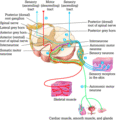Chapter 22: Cancer pain assessment and management
Skip chapter table of contents and go to main content


Nociceptive pain
Nociceptive pain is the ‘normal’ pain pathway that occurs in response to tissue injury or damage (Figure 22.1). It consists of four components: transduction, transmission, perception and modulation. Nociceptors are free nerve endings found at the end of pain neurones. They occur in skin and subcutaneous tissue, muscle, visceral organs, tendons, fascia, joint capsules and arterial walls (Godfrey [85]). Nociceptors respond to noxious thermal stimuli (heat and cold) and mechanical stimuli (stretching, compression, infiltration) and to the chemical mediators released as part of the inflammatory response to tissue injury. These chemical mediators include prostaglandins, bradykinin, substance P, serotonin and adenosine. As a result of this stimulation process, an action potential is generated in the nerve (transduction).

Figure 22.1 Processing of sensory input and motor output by the spinal cord. Source: Tortora and Derrickson ([214]). Reproduced with permission from John Wiley & Sons.
The pain signal is then transmitted along the peripheral nervous system (A delta and C fibres) to the central nervous system, arriving at the dorsal horn of the spinal cord. Neurotransmitters are released to allow the pain signal to be transmitted from the endings of the peripheral nerves to the nociceptors in the dorsal horn. The message is then transmitted to the brain where perception of the pain occurs (transmission). Perception is the end‐result of the neuronal activity of pain transmission. The perception of pain includes behavioural, psychological and emotional components as well as physiological processes.
Modulation occurs when the transmission of pain impulses in the spinal cord is changed or inhibited. Modulatory influences on pain perception are complex, involving a gating system which is linked to a descending modulatory pathway. Modulation can occur as a result of a natural release of inhibitory neurotransmitter chemicals that inhibit transmission of pain impulses and therefore produce analgesia. Other interventions, including distraction, relaxation, sense of well‐being, heat/cold therapy, massage and transcutaneous electrical nerve stimulation (TENS), can also help to modulate pain perception. Analgesic medications work by inhibiting some of the chemicals involved in pain transduction and transmission and thus modulating pain perception (Figure 22.2). Pain signals can also be increased by certain factors such as anxiety, fear and low mood/depression.

Figure 22.2 The pain pathway showing key sites for particular analgesic interventions. NSAID, non‐steroidal anti‐inflammatory drug. Source: Dougherty and Lister ([55]).





